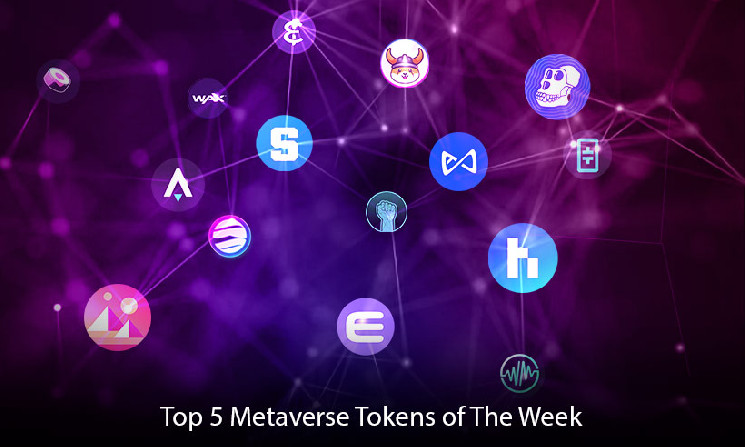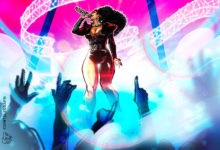Here Are The Top 5 Metaverse Tokens of the Week

Facebook is working on various products to build a Metaverse. The Metaverse Facebook is building will not be decentralized, or censorship-resistant. Nobody wants to be in a Metaverse that is owned by a single entity and has total control over it. This is why there are various Metaverse projects being built in web3. Here is a list of the top 5 Metaverse tokens of the week.
Top 5 Metaverse Tokens of the Week
1. The Sandbox
Creators can monetize their NFT assets and share game experiences on the Ethereum blockchain through the decentralized, community-driven gaming ecosystem known as The Sandbox. Players, artists, and game designers can build assets and experiences, such as games, and art galleries, to share with others using The Sandbox’s free software, such as VoxEdit and the Game Maker. These can be commercialized to generate passive money for the creator. SAND is an Ethereum blockchain-based ERC-20 token. It serves as the ecosystem’s primary utility token, its official currency, and also a governance token. As a result, to purchase and trade non-fungible tokens (NFTs), like LAND and ASSETs, via The Sandbox’s marketplace, $SAND is necessary. The ecology of The Sandbox uses $SAND as the primary form of commerce. It is required to make purchases from the marketplace within The Sandbox. It is necessary to buy:
- Gems and Catalysts for LAND Assets, Custom Avatars.
- LAND: A virtual parcel of land in the metaverse of The Sandbox.
- To create digital experiences like games or dioramas, game designers use LAND.
2. Decentraland
The Ethereum blockchain powers the decentralized virtual reality platform known as Decentraland. Users may produce, consume, and monetize their content and applications on the Decentraland platform. The non-fungible digital asset stored in an Ethereum smart contract representing the limited, navigable, 3D virtual space within Decentraland is called LAND. The division of land into parcels is done using cartesian coordinates (x,y). Community members buy these parcels using MANA, the cryptocurrency token of Decentraland, and they become their permanent property. This allows users to have control over the surroundings and programs they develop, including everything from simple 3D static scenes to more complex programs or games. Some parcels are divided up into themed neighborhoods, called Districts. The community can create shared places with shared interests and uses by dividing parcels into Districts. In exchange for LAND plots, MANA is burned or spent. You can visit the MANA Token Information transparency dashboard on the official website for a current summary of essential statistics, including total and circulating supply. Users can trade MANA with other users in return for goods and services hosted within Decentraland in addition to burning MANA in exchange for LAND.
3. Enjin
With the help of a blockchain PaaS (Platform as a Service), you can design and manage blockchain games without worrying about creating and maintaining the infrastructure traditionally needed to produce and release a blockchain game. With the Enjin Platform, game developers can easily include blockchain gaming into their games by creating what they need with a flexible API, utilizing our SDKs along the way, and using our extensive documentation. Utility of ENJ owners has the flexibility to convert their NFTs back into ENJ at any moment, boosting their trust in the products and initiatives on offer. NFTs’ provenance is established, and their compatibility with the Enjin ecosystem is ensured by the ENJ contained within them. Because ENJ is closely connected with the perceived value of NFTs, it serves as a reliable benchmark. The supply of current NFTs decreases due to melting them, boosting their value. Unlike other digital assets, ENJ-backed NFTs can be destroyed at any time and are generated with something of worth. The only method to control asset development is to back NFTs with ENJ because it is a scarce, valued resource.
4. Render Network
The Render Network aims to link users looking for render jobs to others with accessible GPUs to execute the renders. To receive and finish rendering jobs using OctaneRender, owners would link their GPUs to the Render Network. Users would transfer RNDR tokens to the person doing the rendering, and OTOY would get a small cut of RNDR in exchange for handling the transaction and managing the Render Network. These GPU owners can start earning RNDR Tokens once they’ve registered their idle GPUs on the Render Network as «Node Operators.» They accomplish this by taking on assignments from «Creators,» or people in need of rendering work, who upload their files to the Render Network and assign operators to them. To keep the network running and help with transactions, Render gets a little portion of the RNDR distributed. RNDR Tokens and RNDR Credits are the two sources that power the RNDR Network. These utility tokens are based on the ERC-20 standard. RNDR coins are used to fuel rendering tasks on the RNDR Network. In contrast to RNDR Credits, RNDR tokens can be bought and sold on exchanges, and Node Operators can earn them for the services they provide on their nodes. New users and people unfamiliar with cryptocurrency can quickly start using the network while getting used to it by purchasing RNDR Credits. RNDR Credits, as opposed to RNDR Tokens, can be bought through the RNDR Portal on rndr.otoy.com using PayPal and Stripe.
5. Radio Caca
The RACA DAO is the body that controls several facets of the RACA project, such as token utility and distribution, and it unites the larger RACA community behind initiatives that foster the project’s expansion. This varied group of leaders works together to ensure that everyone who joins the RACA community has the greatest possible experience as an investor and player. There are just a few states in the USM Metaverse that offer limited parcels for free purchase and possession. Each state offers a wealth of exciting traits to discover, allowing you to travel, make new friends, contribute to society, and construct a true metaverse. You can obtain u-RACA, the sole token in the USM Metaverse, by putting RACA from your wallet into the USM account and exchanging it 1:1. It serves as the required transaction fee and can be used to buy various NFT assets or props in USM, including real estate, buildings, cars, concert tickets, and more. You may use and empower any NFTs you’ve ever obtained in the RACA community in USM.
Conclusion
So, these are the top 5 Metaverse tokens of the week. Each Metaverse project is trying to do something different. A lot of work has been done on these projects but still, they lack the infrastructure to support millions of users on their platform. More improvements in the interoperability layer, user experience, and scalability will enable these projects to onboard millions of users. These 5 projects are the biggest and most user-friendly in metaverse space. They might continue to surprise their users with innovation. Do your research before investing in any project. This article is for educational purposes only and shouldn’t be misconstrued as investment advice.






 Bitcoin
Bitcoin  Ethereum
Ethereum  Tether
Tether  USDC
USDC  TRON
TRON  Dogecoin
Dogecoin  Cardano
Cardano  Bitcoin Cash
Bitcoin Cash  Chainlink
Chainlink  Monero
Monero  LEO Token
LEO Token  Zcash
Zcash  Stellar
Stellar  Litecoin
Litecoin  Hedera
Hedera  Dai
Dai  Cronos
Cronos  Tether Gold
Tether Gold  OKB
OKB  Ethereum Classic
Ethereum Classic  KuCoin
KuCoin  Gate
Gate  Algorand
Algorand  Cosmos Hub
Cosmos Hub  VeChain
VeChain  TrueUSD
TrueUSD  Dash
Dash  Tezos
Tezos  Stacks
Stacks  IOTA
IOTA  Basic Attention
Basic Attention  Decred
Decred  Theta Network
Theta Network  NEO
NEO  Synthetix
Synthetix  Qtum
Qtum  Ravencoin
Ravencoin  0x Protocol
0x Protocol  DigiByte
DigiByte  Nano
Nano  Zilliqa
Zilliqa  Holo
Holo  Siacoin
Siacoin  Numeraire
Numeraire  Waves
Waves  BUSD
BUSD  Status
Status  Pax Dollar
Pax Dollar  Enjin Coin
Enjin Coin  Ontology
Ontology  Hive
Hive  Lisk
Lisk  Steem
Steem  Huobi
Huobi  NEM
NEM  OMG Network
OMG Network  Bitcoin Gold
Bitcoin Gold  Augur
Augur  HUSD
HUSD  Ren
Ren